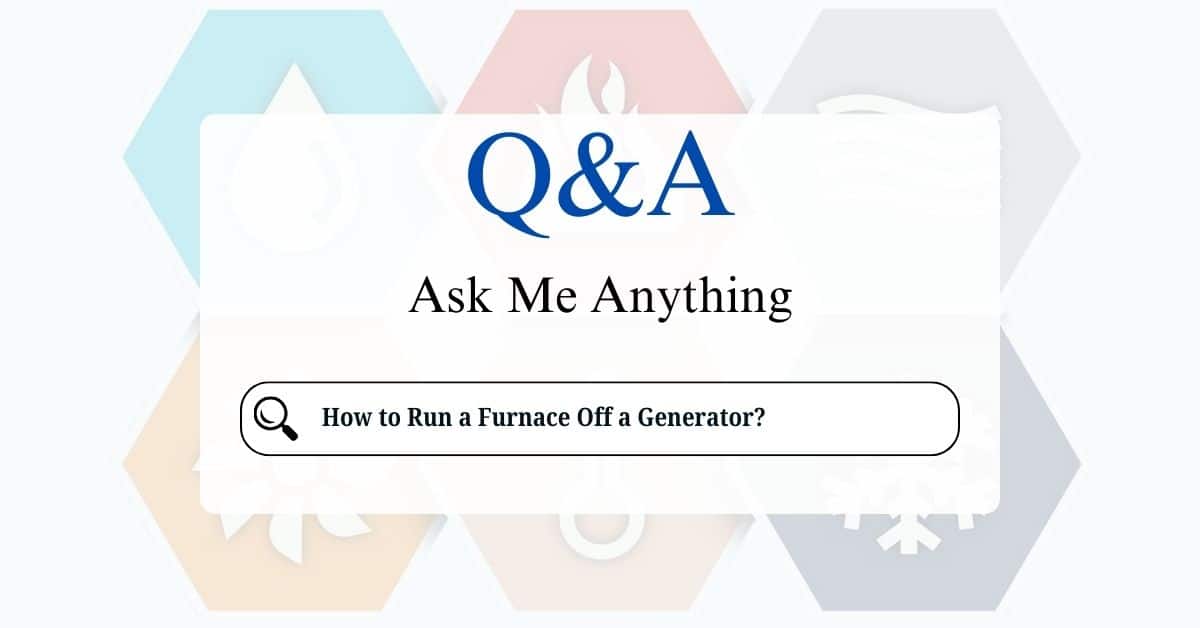Power outages can be a real headache, especially during the colder months when you rely on your furnace for warmth. While a generator can be a lifesaver in these situations, connecting it to your furnace requires careful planning and execution. This guide will walk you through the essential steps to safely and effectively run your furnace off a generator.
Important Considerations Before You Begin:
- Generator Size (Crucial): This is the most critical factor. Your generator must be powerful enough to handle the starting wattage (the surge of power required when the furnace first turns on) and the running wattage (the power required to keep it running). Check your furnace’s nameplate for its wattage requirements. The starting wattage is usually significantly higher than the running wattage. A generator that’s too small will not be able to start your furnace and could even be damaged. As a general rule, a generator with a running wattage of at least 5000 watts is recommended for most furnaces, but always check your furnace’s specific requirements.
- Type of Generator: Inverter generators are generally preferred for powering sensitive electronics like modern furnaces because they produce cleaner power (less total harmonic distortion). This is especially important for furnaces with electronic control boards. Conventional generators can work, but they may not be ideal for all furnace models.
- Extension Cords: Use heavy-duty, outdoor-rated extension cords that are rated for the amperage draw of your furnace. Using undersized cords can cause voltage drop, which can damage your furnace or the generator.
- Safety First: Carbon monoxide poisoning is a serious risk when using generators. Always operate your generator outdoors in a well-ventilated area, away from windows, doors, and vents. Never run a generator indoors, including garages or sheds. Install carbon monoxide detectors in your home and ensure they are functioning correctly.
Connecting Your Furnace to a Generator
There are two main ways to connect your furnace to a generator:
1. Using an Extension Cord (Simpler, for Basic Furnaces):
- Turn Off the Furnace: Turn off the power to the furnace at the breaker box or the furnace’s power switch.
- Locate the Furnace’s Power Cord: Find where the furnace is plugged into the electrical outlet.
- Unplug the Furnace: Unplug the furnace from the outlet.
- Connect the Extension Cord: Plug one end of the heavy-duty extension cord into the generator’s outlet and the other end into the furnace’s power cord.
- Start the Generator: Start the generator according to the manufacturer’s instructions.
- Turn On the Furnace: Turn the power back on to the furnace at the breaker box or the furnace’s power switch.
2. Using a Transfer Switch (Safer, More Permanent Solution):
A transfer switch is a much safer and more convenient way to connect your furnace (and other essential circuits) to a generator. It isolates your home’s circuits from the utility power grid, preventing backfeeding, which is dangerous for utility workers and can damage your generator.
- Professional Installation Recommended: Transfer switches should be installed by a qualified electrician. This ensures the installation is done correctly and meets all electrical codes.
- How it Works: A transfer switch is connected to your home’s electrical panel. During a power outage, you switch over to generator power using the transfer switch. This disconnects your home from the utility grid and connects it to the generator.
- Connecting the Generator: You connect the generator to the transfer switch using a dedicated power inlet box.
- Starting the Generator and Switching Over: Start the generator and then follow the instructions on the transfer switch to switch over to generator power.
Important Considerations When Using a Generator with Your Furnace
- Monitor the Generator: Regularly check the generator’s fuel level and oil level.
- Avoid Overloading the Generator: Do not try to run too many appliances at the same time. This can overload the generator and cause it to shut down or be damaged.
- Turn Off Unnecessary Appliances: Turn off any unnecessary appliances to reduce the load on the generator.
- Cycling: Your furnace might cycle on and off more frequently when running on a generator. This is often due to slight voltage fluctuations and is usually not a cause for concern.
If you are uncomfortable working with electricity or gas appliances, or if you have any doubts about connecting your furnace to a generator, it’s best to call a qualified electrician or HVAC technician. They can ensure the connection is done safely and correctly.
Running your furnace off a generator can provide essential warmth during a power outage. By following these steps and taking the necessary precautions, you can do so safely and effectively. Remember, generator sizing is crucial, and safety is always the top priority. If you have any doubts, consult a professional.






